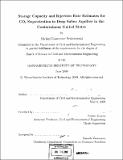Storage capacity and injection rate estimates for CO₂ sequestration in deep saline aquifers in the conterminous United States
Author(s)
Szulczewski, Michael Lawrence
DownloadFull printable version (30.10Mb)
Other Contributors
Massachusetts Institute of Technology. Dept. of Civil and Environmental Engineering.
Advisor
Ruben Juanes.
Terms of use
Metadata
Show full item recordAbstract
A promising method to mitigate global warming is injecting CO₂ into deep saline aquifers. In order to ensure the safety of this method, it is necessary to understand how much CO₂ can be injected into an aquifer and at what rate. Since offsetting nationwide emissions requires storing very large quantities of CO₂, these properties must be understood at the large scale of geologic basins. In this work, we develop simple models of storage capacity and injection rate at the basin scale. We develop a storage capacity model that calculates how much CO₂ an aquifer can store based on how the plume of injected CO₂ migrates. We also develop an injection rate model that calculates the maximum rate at which CO₂ can be injected into an aquifer based on the pressure rise in the aquifer. We use these models to estimate storage capacities and maximum injection rates for a variety of reservoirs throughout the United States, and compare the results to predicted emissions from coal-burning power plants over the next twenty-five years and fifty years. Our results suggest that the United States has enough storage capacity to sequester all of the CO₂ emitted from coal-burning plants over the next 25 years. Furthermore, our results indicate that CO₂ can be sequestered at the same rate it is emitted for this time period without fracturing the aquifers. For emissions over the next 50 years, however, the results are less clear: while the United States will likely have enough capacity, maintaining sufficiently high injection rates could be problematic.
Description
Thesis (S.M.)--Massachusetts Institute of Technology, Dept. of Civil and Environmental Engineering, 2009. Includes bibliographical references (p. 141-148).
Date issued
2009Department
Massachusetts Institute of Technology. Department of Civil and Environmental EngineeringPublisher
Massachusetts Institute of Technology
Keywords
Civil and Environmental Engineering.